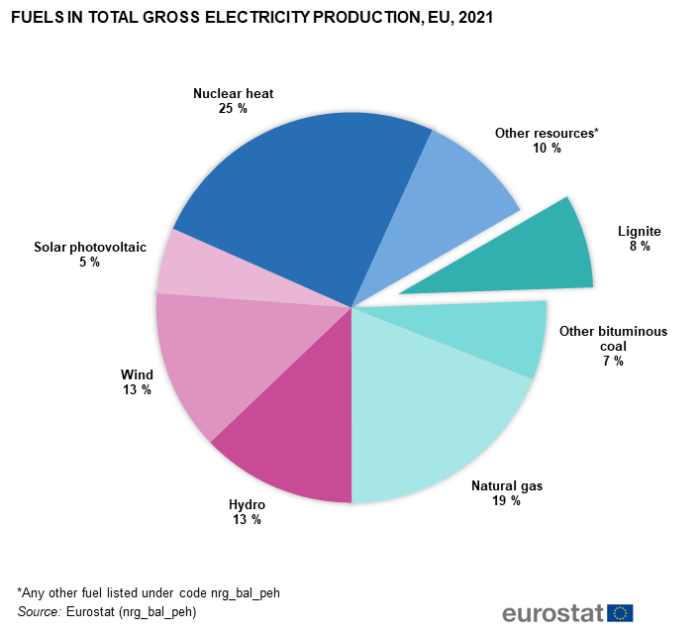Production of lignite in the EU - statistics
Data extracted in June 2023
Planned article update: June 2024
Highlights
In 2021, 8 % of the total gross electricity produced in the EU was based on lignite, dropping from 2019 and representing around 225 000 GWh.
In 2022, Germany accounted for 44 % of the total lignite produced in the EU.
This article explains how production of lignite in the European Union (EU) has evolved since 1990, and highlights its use for electricity generation. The article also gives figures on the transformation efficiency of lignite compared with other fuels. As almost all lignite produced by EU Member States is used domestically, lignite trade in the EU is negligible. Therefore, this article focuses on inland production and consumption.
Full article
What is lignite and how significant is this fossil fuel in the EU?
Lignite is a type of solid fossil fuel. Together with sub-bituminous coal, lignite is part of the so-called 'brown coal' group. Compared with hard coals (anthracite, other bituminous coal, coking coal), lignite has a low energy content i.e. a low calorific value. In practice, lignite's calorific value is about 10 MJ/kg, depending on the EU Member State and the individual mine concerned, which is well below the maximum official gross calorific value (20 MJ/kg) as described in Regulation (EU) No 2146/2019.
Despite its low energy content, lignite is one of the few primary energy resources that is available in relatively large quantities on the national territory of some EU Member States. Using lignite is often cheaper than importing other fossil fuels and limits energy dependency.
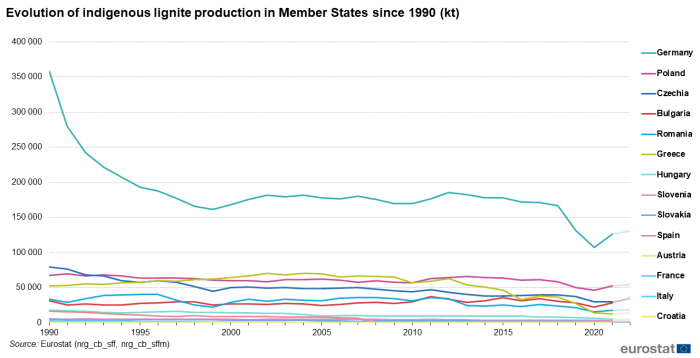
Source: Eurostat (nrg_cb_sff), (nrg_cb_sffm)

Source: Eurostat (nrg_cb_sff), (nrg_cb_sffm)
In 1990, 14 EU Member States produced in total 671 million tonnes of lignite. This production continuously decreased to reach 294 million tonnes in 2022 (see Figure 1). This decrease accelerated in 2019 and 2020, but since 2021, lignite production has experienced a small rise but with 2022 figures still below those of 2019. Today, lignite is still produced by nine EU Member States, with Germany accounting for about 44 % of the total European lignite production (see Figure 2).
The 2022 numbers in Figures 1 and 2 are based on cumulative monthly data.
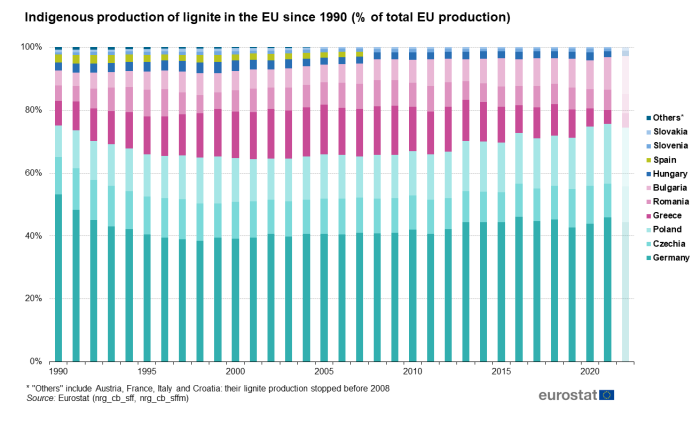
Source: Eurostat (nrg_cb_sff), (nrg_cb_sffm)
Over the period 1990-2022, around 90 to 95 % of total lignite in the EU was produced by six Member States: Germany, Poland, Bulgaria, Czechia, Romania and Greece. In 2022, the indigenous production of lignite in Germany (44 %), Poland (19 %), Bulgaria (12 %), Czechia (11 %), Romania (6 %) and Greece (5 %) all together accounted for 97 % of total EU production (see Figure 2 and Cover Figure). Hungary, Slovenia and Slovakia produced lignite in very low quantities. Production in Spain continuously decreased from 1990 (16 million tonnes) to 2007 which was the last year of production. Production in Croatia, Italy, France and Austria, which did not exceed 2.5 million tonnes per year, stopped before 2005.
What is lignite used for and how is it different from other fuels?
The nine countries producing lignite used 92 % of the lignite they extracted in 2021 for electricity and heat production (see Figure 3).
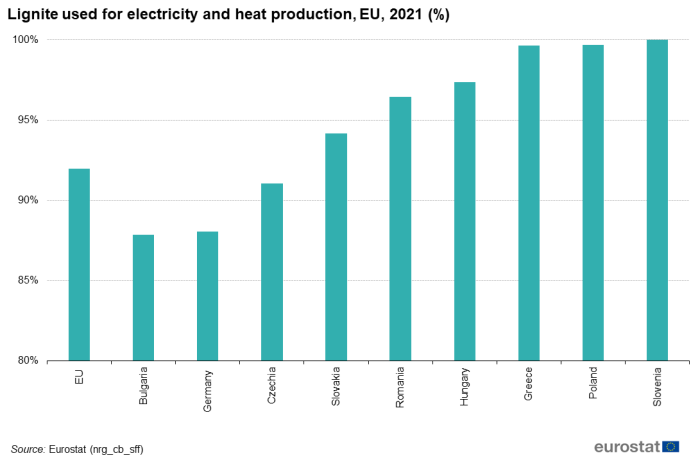
Source: Eurostat (nrg_cb_sff)
Lignite is used exclusively for electricity and heat production in Slovenia, and quasi-exclusively (more than 99 %) in Greece and Poland. The remaining proportion is used by industry and other sectors like households and agriculture in these countries. In other EU Member States such as Bulgaria, Czechia and Germany, lignite was also used to produce other energy products such as brown coal briquettes or coke oven coke. With regard to the EU, these products represented about 8 % of the lignite extracted in 2021, including direct use by households and industry (in particular the chemical and petro-chemical industry).
In 2021, 8 % of total gross electricity produced in the EU was based on lignite, representing around 225 000 GWh. In comparison with other fuels, more electricity was produced from lignite than from other bituminous coal in the EU, but solar photovoltaic is catching up on both as a source of electricity. At EU level, nuclear heat and natural gas were the main fuels used for electricity production, representing respectively 25 % and 19 % of total gross electricity production in 2021 (see Figure 4). However, at country level, electricity generated from lignite represented a large proportion in some EU Member States, with the highest shares in Czechia (37 %) and Bulgaria (34 %) (see Figure 5).
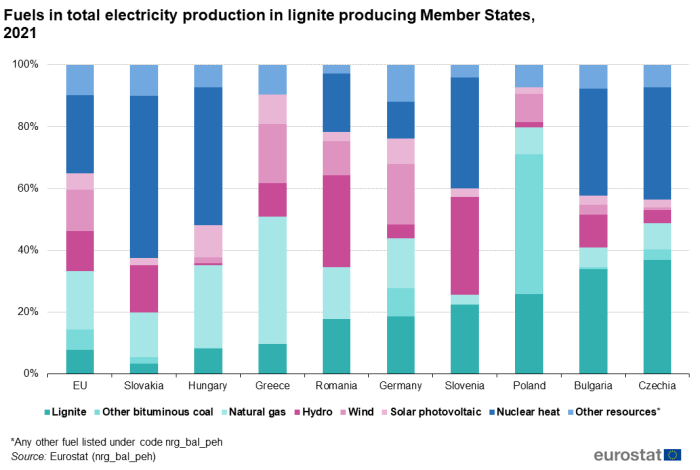
Source: Eurostat (nrg_bal_peh)
What technology is used to transform lignite and how efficient is it?
The two types of plants which use lignite to produce electricity are electricity-only plants and combined heat and power (CHP) plants.

Source: Eurostat (nrg_ind_pehcf)
Over the period 1990-2021, around three-quarters of lignite used for electricity production was generated by electricity-only power plants, while the remaining quarter was used by CHP plants (see Figure 6). To reduce transportation costs, the power plants are usually located next to the mines. Power stations are therefore located far from cities and therefore far from potential customers. Due to the distance from potential customers for the heat, the construction of energy efficient CHP plants exploiting both the electricity and the heat (CHP) has little economic advantage in remote areas. As a result, countries normally choose electricity-only plants to produce electricity from lignite rather than CHP plants. Therefore, the heat produced in the combustion process ends up in the atmosphere.
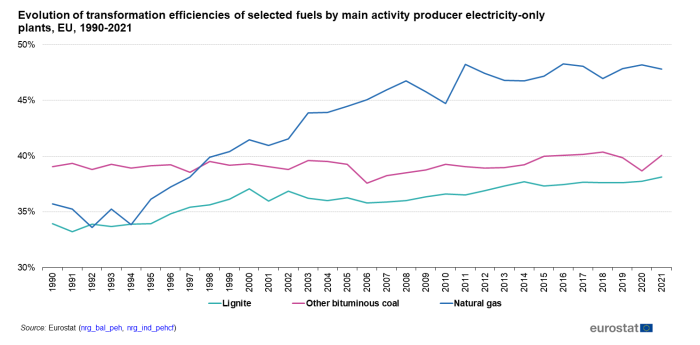
Source: Eurostat (nrg_bal_peh), (nrg_ind_pehcf)
Transformation efficiency refers to the relation between transformation input and transformation output with regards to the energy of a fuel (e.g. transformation of lignite into electricity). Transformation efficiencies of electricity-only plants increased between 1990 and 2021 for natural gas (by 12 percentage points (pp)) compared with lignite (4 pp) and other bituminous coal (remained stable). In general, the transformation efficiency of electricity-only power plants is lower for lignite (38 %) than for other fuels such as other bituminous coal (40 %) and natural gas (48 %) (see Figure 7).
What is the environmental impact of lignite?
All fossil fuels contain carbon, which is released in the form of greenhouse gases (e.g. carbon dioxide, methane) when combusted. Therefore, burning lignite contributes to greenhouse gas emissions. The carbon dioxide emission factor is calculated from the carbon within the fuel. This factor differs depending on lignite quality. The highest value was recorded for Greece with 132.8 tCO2/TJ (see Table 1). This means that burning one terajoule of lignite results in the emission of 132.8 tonnes of CO2 into the atmosphere. The lowest values were reported by Slovakia with 95.4 tCO2/TJ and by Romania with 95.8 tCO2/TJ. In general, the carbon emission factor in the EU is higher for lignite (101.2 tCO2/TJ) compared with other fuels such as other bituminous coal (94.6 tCO2/TJ) and natural gas (56.1 tCO2/TJ; see Table 1). Therefore, one GWh of electricity produced using lignite results in almost double the amount of CO2 emissions compared with one GWh produced using natural gas.
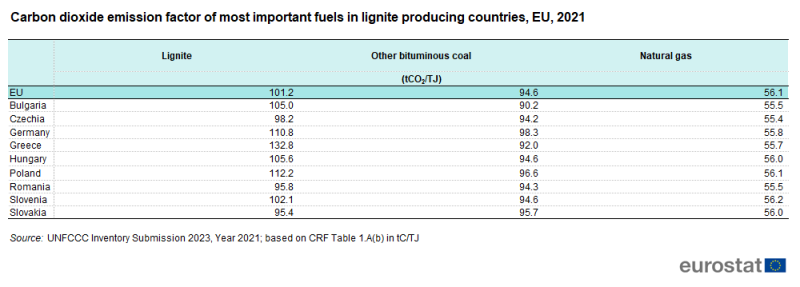
Source: UNFCCC Inventory Submission 2023, Year 2021; based on CRF Table 1.A(b) in tC/TJ
Summary
Although political and economic advantages exist for the use of lignite for electricity and heat generation, lignite is mainly extracted from open-air mines which leads to land destruction. Furthermore, this fossil fuel has a high climate change potential in comparison with other fuels, and is used by power plants with relatively low efficiency in producing electricity (electricity-only plants compared with CHP plants). Given the current discussions on climate change at European and global level, EU Member States continuously reduced its use since 1990. This is also an effect of the EU Emissions Trading System (EU ETS) which makes the use of lignite less and less economically rewarding, as for each tonne of CO2 released into the atmosphere, the CO2 emitter has to buy emission allowances.
Source data for tables and graphs
Data sources
The production and consumption data of hard coal and lignite between 1990 and 2021 are based on data from the annual solid fossil fuels questionnaire. For the latest available 2022 data, cumulative monthly data was used. These cumulative monthly data could be considered as provisional/estimates of annual statistics.
The data related to electricity production, the share of lignite in it and the measured plant efficiencies are based on data from the annual electricity and heat questionnaire.
The data related to carbon emissions is based on the EU's Inventory Submission to the United Nations Framework Convention on Climate Change (UNFCCC).
Context
The Energy statistics Regulation (EC) No 1099/2008 is the legal basis for the reporting of annual energy questionnaires.
Direct access to
- Energy Statistics - main indicators (t_nrg_indic)
- Final energy consumption by product (ten00123)
- Energy statistics - quantities (nrg_quant)
- Energy statistics - quantities, annual data (nrg_quanta)
- Supply, transformation and consumption of solid fossil fuels (nrg_cb_sff)
- Energy statistics - quantities, annual data (nrg_quanta)
- Energy statistics - quantities (nrg_quant)
- Energy statistics - quantities, annual data (nrg_quanta)
- Production of electricity and derived heat by type of fuel (nrg_bal_peh)
- Energy statistics - quantities, annual data (nrg_quanta)
- Energy statistics - quantities (nrg_quant)
- Energy statistics - quantities, annual data (nrg_quanta)
- Gross production of electricity and derived heat from combustible fuels by type of plant and operator (nrg_ind_pehcf)
- Energy statistics - quantities, annual data (nrg_quanta)
Visualisations
- Supply, transformation and consumption - commodity balances (annual) - ESMS metadata file (nrg_cb_esms)
- Energy statistics - quantities - ESMS metadata file (nrg_quant_esms)
- Energy statistics - supply, transformation, consumption (monthly) - ESMS metadata file (nrg_10m_esms)
- Regulation (EC) No 1099/2008 of 22 October 2008 on energy statistics
- Summaries of EU legislation: Common system for the production of energy statistics

